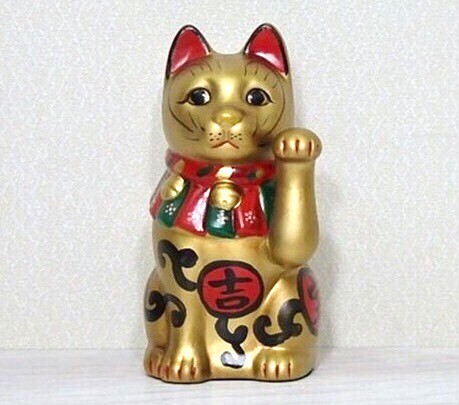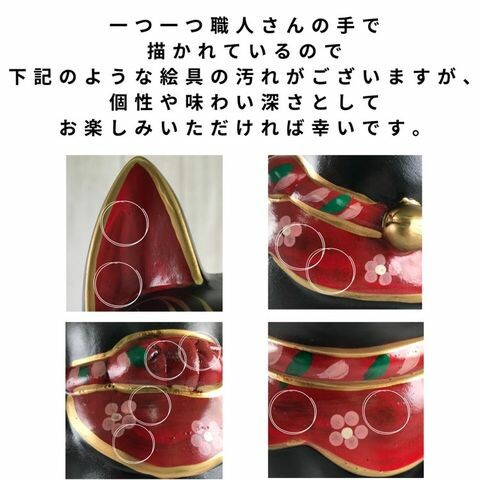


厂商详情
Mitsui Pottery Inc.
| 地址 | 1084 Dachi-chou Toki-shi Gifu, 日本邮编:509-5401 |
|---|---|
| 负责人姓名 | Toshihiro Fujii |
| 年收 | 不显示 |
| 公司人数 | 5 |
| 网址 |





其他人感兴趣的
此类产品中的其他产品
SD商品编号:7253403
| 详情 | 价格 & 数量 | ||
|---|---|---|---|
| S1 |
Kissho Koshoku Taisho Neko(小)金招财猫,约 19.5 厘米。
吉祥古色大正猫(小)金招き猫 19.5cm 約19.5cm
(87110-579)
|
(87110-579)
批发价: 仅限会员
1点/组
售罄
|
|
| 出货时期 |
|---|
|
约10天
|
| 尺寸 |
|---|
|
约19.5厘米
|
| 商品规格 |
|---|
描述
| 〜招财猫已有 1300 年的历史。 一直以来,招财猫都是人们喜爱的吉祥物,它能带来生意兴隆、家庭幸福和顾客盈门。 [招财猫的历史] 虽然日本自古以来就有野生野猫栖息,但并没有我们今天所知的家猫作为宠物。猫作为驯化猫来到日本是在奈良时代(710-794 年)。它们随佛教从中国传入日本。据说当时人们将猫放在船上,以保护佛经和书籍不被老鼠损坏。 关于猫的最早记载见于平安时代早期(794-1185 年)的《日本书记》,《枕中记》和《源氏物语》中也有关于驯养猫的描述,这表明至少在平安时代,人们就已经熟悉猫了。[红猫的含义] 红猫是祛病的象征,也是祈求长寿的象征。 [金猫]金猫一直受到人们的喜爱,被视为招财猫,也被用来祈求生意兴隆和活动成功。 [举起左手的招财猫] 举起左手的招财猫是一只[邀请人们]的猫。因此,它经常被摆放在餐厅、服务行业和其他希望有很多顾客光临的地方。 [举手长短的含义]。 举手的高度也有区别。举过耳朵的手称为[te-chou],而适度举过耳朵的手称为[te-shou]。人们认为,手伸得越长,越能招来遥远而巨大的好运,而手短则能招来熟悉而微薄的幸福。 [它们所携带物品的含义]。 招财猫的形象是手持 "工班",但早期的招财猫并没有 "工班",大多数招财猫的衣领上都挂着一个铃铛。据说,这种铃铛后来逐渐变成了 "呼班"。公盘上绘有金额和 "开运"、"福禄 "等吉祥语,直接反映了招财猫的愿望。有趣的是,随着时间的推移,招财猫上描绘的钱数也在不断增加,从 [千两] [万两] [万两] 到 [亿两]。基本上,金额越少,就越被认为是年代久远的古板。 东西南北,放在哪里?z 如果是商店,招财猫的基本摆放位置是店门口;如果是住宅,招财猫的基本摆放位置是大门口。在这里您可以招来好运和福气。如果放在家里,也可以放在客厅或其他家人经常能看到的地方。 #日本制造#世通器 请点击这里订购我们的产品目录,其中包含约 20,000 种商品。 我们还有许多其他幸运饰品,如招财猫、浣熊狗和猫头鹰等! 点击此处查看! |
更多
| 配送方法 | 估计到达 |
|---|---|
| Sea Mail | 从 2025年11月25日 到 2026年01月27日 |
| Air Mail | 从 2025年11月07日 到 2025年11月11日 |
| EMS | 从 2025年11月06日 到 2025年11月11日 |
| Pantos Express | 从 2025年11月10日 到 2025年11月13日 |
| DHL | 从 2025年11月06日 到 2025年11月10日 |
| UPS | 从 2025年11月06日 到 2025年11月10日 |
| FedEx | 从 2025年11月06日 到 2025年11月10日 |
|
某些交易条件可能仅适用于日本
由于陶器的性质,可能有颜色上的差异。请欣赏每件作品的不同外观。
我们与一些制造商共享库存。 我们定期更新我们的库存,但可能会暂时缺货。 然而,有时我们可能别无选择,只能因库存暂时短缺而取消您的订单。 如果你想知道最新的库存状况,请联系我们。 |
一直以来,招财猫都是人们喜爱的吉祥物,它能带来生意兴隆、家庭幸福和顾客盈门。
[招财猫的历史]
虽然日本自古以来就有野生野猫栖息,但并没有我们今天所知的家猫作为宠物。猫作为驯化猫来到日本是在奈良时代(710-794 年)。它们随佛教从中国传入日本。据说当时人们将猫放在船上,以保护佛经和书籍不被老鼠损坏。
关于猫的最早记载见于平安时代早期(794-1185 年)的《日本书记》,《枕中记》和《源氏物语》中也有关于驯养猫的描述,这表明至少在平安时代,人们就已经熟悉猫了。[红猫的含义]
红猫是祛病的象征,也是祈求长寿的象征。
[金猫]金猫一直受到人们的喜爱,被视为招财猫,也被用来祈求生意兴隆和活动成功。
[举起左手的招财猫]
举起左手的招财猫是一只[邀请人们]的猫。因此,它经常被摆放在餐厅、服务行业和其他希望有很多顾客光临的地方。
[举手长短的含义]。
举手的高度也有区别。举过耳朵的手称为[te-chou],而适度举过耳朵的手称为[te-shou]。人们认为,手伸得越长,越能招来遥远而巨大的好运,而手短则能招来熟悉而微薄的幸福。
[它们所携带物品的含义]。
招财猫的形象是手持 "工班",但早期的招财猫并没有 "工班",大多数招财猫的衣领上都挂着一个铃铛。据说,这种铃铛后来逐渐变成了 "呼班"。公盘上绘有金额和 "开运"、"福禄 "等吉祥语,直接反映了招财猫的愿望。有趣的是,随着时间的推移,招财猫上描绘的钱数也在不断增加,从 [千两] [万两] [万两] 到 [亿两]。基本上,金额越少,就越被认为是年代久远的古板。
东西南北,放在哪里?z
如果是商店,招财猫的基本摆放位置是店门口;如果是住宅,招财猫的基本摆放位置是大门口。在这里您可以招来好运和福气。如果放在家里,也可以放在客厅或其他家人经常能看到的地方。
#日本制造#世通器
请点击这里订购我们的产品目录,其中包含约 20,000 种商品。
我们还有许多其他幸运饰品,如招财猫、浣熊狗和猫头鹰等!
点击此处查看!
The beckoning cat has long been loved as a good-luck charm that brings prosperity in business, happiness in the family, and the arrival of many customers.
[History of the beckoning cat]
Although wild wild cats have inhabited Japan since ancient times, there were no domestic cats as pets as we know them today. Cats as domesticated cats came to Japan during the Nara period (710-794). They came to Japan with Buddhism from China. It is said that they were carried on ships to protect Buddhist scriptures and books from damage by rats.
The earliest mention of cats is found in the "Nihon ryoiki" written in the early Heian period (794-1185), and there are also descriptions of domesticated cats in the "Pillow Book" and "Tale of Genji", suggesting that they were familiar to people at least in the Heian period. [Meaning of the red cat]
Red cats are prized as a symbol to ward off illness, and are also popular as a prayer for long life.
[Golden cat] The golden cat continues to be loved by people as a beckon for good fortune, as well as a prayer for prosperity and success in business and events.
[Maneki neko with its left hand raised]
A beckoning cat with its left hand raised is a cat that [invites people]. For this reason, it is often placed in restaurants, service businesses, and other places where people want many customers to come.
[Meaning of the length of the upraised hand].
There is also a difference in the height of the raised hand. A hand raised above the ear is called [te-chou], while a hand raised modestly below the ear is called [te-shou]. It is believed that the longer the hand is extended, the more it invites distant and great good fortune, while a short hand invites familiar and modest happiness.
[Meaning of the items they carry].
The image of a beckoning cat is that of holding a koban, but early beckoning cats did not have kobans, and most had a bell hanging from their collars. It is said that this bell gradually changed to a koban. The koban is painted with an amount of money and auspicious words such as "kaiun" (good luck) and "sho-fuku" (good fortune), directly reflecting the wish that was put into the beckoning cat. It is interesting to note that the amount of money depicted on the koban has increased over time from [senryo] [ten thousand ryo] [ten thousand ryo] to [billion ryo]. The more modest the amount, the older the koban is considered to be, basically.
Where do you put it, east, west, south, north, south, east? z
The basic place to place a beckoning cat is in front of a store if it is a store, or at the front door if it is a home. This is the place where you can invite good fortune and luck to come to you. If you place it at home, you can also place it in the living room or other places where the family can see it often.
#Made in Japan#Seto ware
Please click here to order our product catalog with approximately 20,000 items.
We also have many other lucky ornaments such as beckoning cats, objet d'art raccoon dogs, and owls!
Click here to see them!